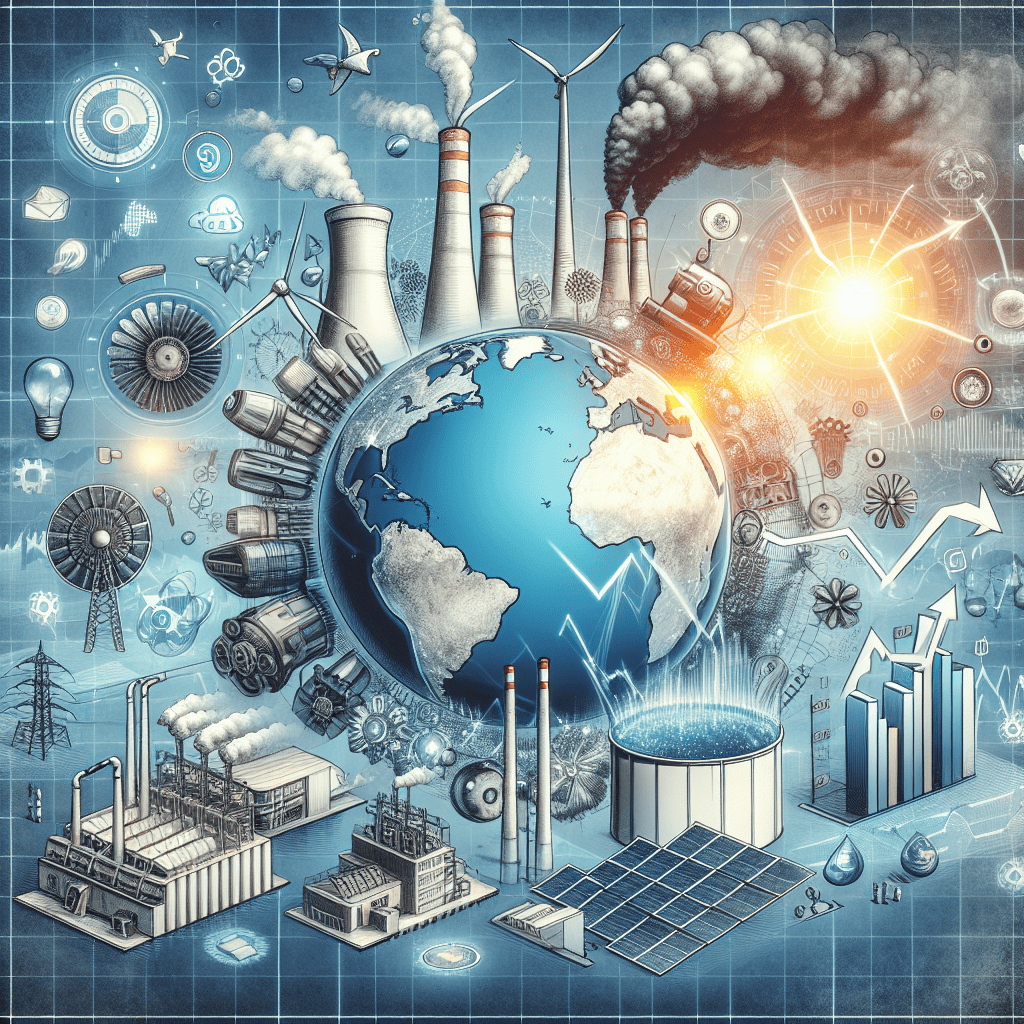“Powering Insights: Navigating the Future of Energy & Utilities”
Introduction
Energy & Utilities Roundup: Market Talk provides a comprehensive overview of the latest trends, developments, and insights within the energy and utilities sectors. This roundup serves as a vital resource for industry professionals, investors, and stakeholders seeking to stay informed about market dynamics, regulatory changes, technological advancements, and economic factors influencing these critical industries. By aggregating expert analyses, market data, and key news highlights, Energy & Utilities Roundup: Market Talk offers a concise yet thorough examination of the forces shaping the future of energy production, distribution, and consumption, as well as the utilities that support modern infrastructure and services.
Renewable Energy Innovations
In recent years, the renewable energy sector has witnessed a remarkable surge in innovation, driven by the urgent need to transition towards more sustainable energy sources. This shift is not only a response to the growing concerns over climate change but also a reflection of the technological advancements that have made renewable energy more accessible and cost-effective. As we delve into the latest developments in this dynamic field, it becomes evident that the landscape of energy and utilities is undergoing a profound transformation.
To begin with, solar energy continues to be at the forefront of renewable innovations. The advent of perovskite solar cells, for instance, has garnered significant attention due to their potential to revolutionize the solar industry. These cells offer a promising alternative to traditional silicon-based solar panels, primarily because they are cheaper to produce and can be manufactured using less energy. Moreover, their flexibility and lightweight nature make them suitable for a wide range of applications, from rooftop installations to portable solar devices. As research progresses, the efficiency and stability of perovskite solar cells are expected to improve, further solidifying their role in the future of solar energy.
In parallel, wind energy is also experiencing noteworthy advancements. Offshore wind farms, in particular, are gaining momentum as a viable solution to harness the power of wind on a larger scale. The development of floating wind turbines has opened up new possibilities for deploying wind farms in deeper waters, where wind speeds are typically higher and more consistent. This innovation not only expands the geographical scope of wind energy projects but also minimizes the visual and environmental impact on coastal communities. As countries around the world set ambitious targets for reducing carbon emissions, the expansion of offshore wind capacity is poised to play a crucial role in meeting these goals.
Furthermore, energy storage technologies are evolving rapidly, addressing one of the most significant challenges associated with renewable energy: intermittency. The integration of advanced battery systems, such as lithium-ion and solid-state batteries, is enhancing the reliability and efficiency of renewable energy sources. These storage solutions enable the capture and retention of excess energy generated during peak production periods, ensuring a steady supply even when the sun isn’t shining or the wind isn’t blowing. As a result, energy storage is becoming an indispensable component of modern energy systems, facilitating the seamless integration of renewables into the grid.
Additionally, the concept of smart grids is gaining traction as a means to optimize energy distribution and consumption. By leveraging digital technologies and data analytics, smart grids enable real-time monitoring and management of energy flows, enhancing the overall efficiency and resilience of the power network. This innovation not only supports the integration of diverse energy sources but also empowers consumers to make informed decisions about their energy usage. As smart grid infrastructure continues to evolve, it holds the potential to transform the way we produce, distribute, and consume energy, paving the way for a more sustainable and interconnected energy ecosystem.
In conclusion, the renewable energy sector is witnessing a wave of innovations that are reshaping the energy and utilities landscape. From advancements in solar and wind technologies to breakthroughs in energy storage and smart grid systems, these developments are driving the transition towards a more sustainable and resilient energy future. As the world continues to grapple with the challenges of climate change and energy security, the importance of fostering innovation in renewable energy cannot be overstated. The ongoing efforts to harness the power of nature through cutting-edge technologies are not only crucial for reducing our carbon footprint but also for ensuring a sustainable and prosperous future for generations to come.
Smart Grid Technologies
In recent years, the energy and utilities sector has witnessed a transformative shift, largely driven by the advent and integration of smart grid technologies. These innovations are not only reshaping the way energy is distributed and consumed but are also paving the way for a more sustainable and efficient future. As the global demand for energy continues to rise, the need for smarter, more resilient grid systems becomes increasingly apparent. Smart grid technologies, characterized by their ability to enhance communication, automation, and data management within the energy infrastructure, are at the forefront of this evolution.
One of the primary advantages of smart grid technologies is their capacity to improve energy efficiency. By utilizing advanced metering infrastructure (AMI), utilities can gather real-time data on energy consumption patterns. This data enables more accurate demand forecasting and load management, reducing energy waste and optimizing resource allocation. Furthermore, smart grids facilitate the integration of renewable energy sources, such as solar and wind, into the existing grid. This integration is crucial for reducing carbon emissions and achieving sustainability goals, as it allows for a more balanced and reliable energy supply.
In addition to enhancing efficiency, smart grid technologies also bolster grid reliability and resilience. Traditional power grids are often vulnerable to disruptions caused by natural disasters, equipment failures, or cyber-attacks. However, smart grids employ sophisticated sensors and automated controls that can quickly detect and respond to such disturbances. This capability minimizes downtime and ensures a more stable energy supply, which is essential for both residential and industrial consumers. Moreover, the implementation of distributed energy resources (DERs), such as microgrids and energy storage systems, further strengthens grid resilience by providing localized power solutions during outages.
The economic implications of smart grid technologies are also noteworthy. By reducing operational costs and improving energy efficiency, utilities can pass on savings to consumers, resulting in lower energy bills. Additionally, the deployment of smart grid infrastructure creates new job opportunities in fields such as engineering, data analysis, and cybersecurity. As governments and private entities continue to invest in smart grid projects, the potential for economic growth within the energy sector is substantial.
Despite these benefits, the transition to smart grid technologies is not without challenges. The initial investment required for upgrading existing infrastructure can be significant, posing a barrier for some utilities. Furthermore, the integration of advanced technologies necessitates a skilled workforce capable of managing and maintaining these systems. To address these challenges, collaboration between government agencies, private companies, and educational institutions is essential. By fostering partnerships and providing training programs, stakeholders can ensure a smooth transition to a smarter energy future.
In conclusion, smart grid technologies represent a pivotal development in the energy and utilities sector. Their ability to enhance efficiency, reliability, and sustainability makes them an indispensable component of modern energy systems. As the world continues to grapple with the dual challenges of increasing energy demand and environmental concerns, the adoption of smart grid technologies offers a promising solution. By embracing these innovations, utilities can not only improve their operations but also contribute to a more sustainable and resilient energy landscape. As we move forward, the continued advancement and implementation of smart grid technologies will undoubtedly play a crucial role in shaping the future of energy and utilities.
Energy Storage Solutions
In recent years, the energy sector has witnessed a significant transformation, driven by the urgent need to transition towards more sustainable and efficient energy systems. Central to this evolution is the development and deployment of advanced energy storage solutions, which are increasingly recognized as pivotal in addressing the intermittency challenges associated with renewable energy sources. As the global demand for clean energy continues to rise, the role of energy storage technologies becomes ever more critical in ensuring a reliable and resilient power supply.
One of the most promising advancements in this field is the rapid improvement in battery technologies, particularly lithium-ion batteries. These batteries have become the cornerstone of energy storage systems due to their high energy density, efficiency, and declining costs. As a result, they are widely used in various applications, ranging from electric vehicles to grid storage solutions. The ongoing research and development efforts are focused on enhancing the performance and lifespan of these batteries, while also exploring alternative materials that could offer even greater benefits. For instance, solid-state batteries, which promise higher energy densities and improved safety, are gaining traction as a potential successor to conventional lithium-ion technology.
In addition to battery storage, other innovative solutions are emerging to complement and enhance the energy storage landscape. Among these, pumped hydro storage remains a well-established and highly effective method for large-scale energy storage. By utilizing gravitational potential energy, pumped hydro systems can store and release significant amounts of electricity, making them ideal for balancing supply and demand on the grid. However, the geographical and environmental constraints associated with these systems necessitate the exploration of more versatile alternatives.
Consequently, technologies such as compressed air energy storage (CAES) and flywheel energy storage are gaining attention for their unique capabilities. CAES systems store energy by compressing air in underground caverns, which can later be released to generate electricity. This method offers a scalable solution with the potential for long-duration storage, although it requires specific geological conditions. On the other hand, flywheel energy storage systems store energy in the form of rotational kinetic energy, providing rapid response times and high power output, which are particularly useful for grid stabilization and frequency regulation.
Furthermore, the integration of energy storage solutions with renewable energy sources is becoming increasingly sophisticated. Hybrid systems that combine solar photovoltaic (PV) panels with battery storage are being deployed to enhance the reliability and efficiency of solar power generation. These systems enable the storage of excess solar energy during peak production periods, which can then be used during times of low sunlight or high demand. Similarly, wind energy projects are incorporating storage solutions to mitigate the variability of wind power and ensure a steady supply of electricity.
As the energy storage market continues to evolve, regulatory frameworks and policy support play a crucial role in facilitating the widespread adoption of these technologies. Governments and industry stakeholders are collaborating to establish standards and incentives that encourage investment in energy storage infrastructure. This collaborative approach is essential for overcoming the technical and economic barriers that currently hinder the full potential of energy storage solutions.
In conclusion, the advancements in energy storage technologies are reshaping the energy landscape, offering new opportunities for enhancing grid stability, integrating renewable energy sources, and reducing carbon emissions. As research and innovation continue to drive progress in this field, energy storage solutions are poised to become a cornerstone of the sustainable energy systems of the future.
Utility Market Trends

In recent years, the utility market has experienced significant transformations driven by technological advancements, regulatory changes, and evolving consumer expectations. As the global energy landscape continues to shift, utility companies are increasingly focusing on sustainability and innovation to meet the demands of a rapidly changing world. This article delves into the current trends shaping the utility market, offering insights into how these developments are influencing the industry.
One of the most prominent trends in the utility market is the growing emphasis on renewable energy sources. As concerns about climate change intensify, governments and organizations worldwide are setting ambitious targets to reduce carbon emissions. This shift is prompting utility companies to invest heavily in renewable energy projects, such as wind, solar, and hydroelectric power. The transition to cleaner energy sources is not only a response to regulatory pressures but also a strategic move to capitalize on the declining costs of renewable technologies. Consequently, the integration of renewables into the energy mix is reshaping the utility market, driving companies to innovate and adapt their business models.
In tandem with the rise of renewable energy, the utility market is witnessing a surge in the adoption of smart grid technologies. These advanced systems enable more efficient management of energy distribution, allowing utilities to optimize their operations and enhance grid reliability. Smart grids facilitate real-time monitoring and control, which helps in balancing supply and demand, reducing energy losses, and improving outage management. As a result, utility companies are increasingly investing in digital infrastructure to support the deployment of smart grid solutions, thereby enhancing their ability to deliver reliable and efficient services to consumers.
Moreover, the utility market is experiencing a paradigm shift in consumer engagement. With the advent of digital technologies, consumers are becoming more informed and empowered, demanding greater transparency and control over their energy usage. This trend is driving utilities to adopt customer-centric approaches, offering innovative solutions such as demand response programs, energy efficiency initiatives, and personalized energy management tools. By leveraging data analytics and digital platforms, utilities can provide tailored services that meet the unique needs of their customers, fostering stronger relationships and enhancing customer satisfaction.
Another significant trend impacting the utility market is the increasing focus on energy storage solutions. As the penetration of intermittent renewable energy sources grows, the need for reliable energy storage systems becomes more critical. Energy storage technologies, such as batteries and pumped hydro storage, play a vital role in stabilizing the grid by storing excess energy generated during periods of low demand and releasing it when demand peaks. This capability not only enhances grid resilience but also supports the integration of renewables, making energy storage a key component of the future utility landscape.
Furthermore, regulatory frameworks are evolving to accommodate these changes in the utility market. Policymakers are implementing measures to encourage the adoption of clean energy technologies and promote competition within the sector. These regulatory shifts are creating new opportunities for utility companies to innovate and diversify their offerings, while also posing challenges as they navigate the complexities of compliance and market dynamics.
In conclusion, the utility market is undergoing a profound transformation driven by the convergence of renewable energy adoption, smart grid technologies, consumer empowerment, energy storage advancements, and regulatory changes. As these trends continue to unfold, utility companies must remain agile and forward-thinking to thrive in this dynamic environment. By embracing innovation and sustainability, the utility sector can play a pivotal role in shaping a cleaner, more efficient, and resilient energy future.
Policy and Regulation Updates
In recent months, the energy and utilities sector has been navigating a complex landscape of policy and regulatory changes that are poised to reshape the industry. As governments worldwide intensify their focus on sustainability and carbon reduction, new regulations are emerging that aim to accelerate the transition to cleaner energy sources. These policy shifts are not only influencing the strategic decisions of energy companies but are also impacting the broader market dynamics.
One of the most significant developments in this arena is the increasing adoption of carbon pricing mechanisms. Many countries are implementing or expanding carbon taxes and cap-and-trade systems to incentivize reductions in greenhouse gas emissions. These measures are designed to internalize the environmental costs of carbon emissions, thereby encouraging companies to invest in cleaner technologies. As a result, energy firms are under pressure to innovate and adapt their operations to align with these regulatory frameworks. This shift is expected to drive significant investment in renewable energy projects, as companies seek to reduce their carbon footprint and comply with new regulations.
In addition to carbon pricing, governments are also introducing stricter emissions standards for power plants and industrial facilities. These regulations are compelling utilities to modernize their infrastructure and adopt cleaner technologies. For instance, the push for electrification in transportation and heating is gaining momentum, with policymakers advocating for the expansion of electric vehicle charging networks and the adoption of electric heat pumps. These initiatives are not only aimed at reducing emissions but also at enhancing energy efficiency and security.
Moreover, the integration of renewable energy sources into the grid is becoming a focal point of regulatory efforts. Policymakers are working to address the challenges associated with the intermittent nature of renewables, such as solar and wind power. To this end, regulations are being crafted to promote the development of energy storage solutions and smart grid technologies. These advancements are crucial for ensuring grid stability and reliability as the share of renewables in the energy mix continues to grow.
Furthermore, the regulatory landscape is also being shaped by the increasing emphasis on energy equity and access. Governments are striving to ensure that the benefits of the energy transition are distributed fairly across all segments of society. This includes initiatives to support low-income households in accessing clean energy solutions and efforts to promote community-based renewable energy projects. By prioritizing energy equity, policymakers aim to foster a more inclusive and sustainable energy future.
In parallel, international cooperation is playing a pivotal role in shaping energy policies. Global agreements, such as the Paris Agreement, are driving countries to set ambitious climate targets and collaborate on cross-border energy initiatives. These international commitments are influencing national policies and encouraging the harmonization of regulatory standards. As countries work together to address the global climate challenge, the energy and utilities sector is witnessing a convergence of policy approaches that are fostering innovation and investment.
In conclusion, the evolving policy and regulatory landscape is presenting both challenges and opportunities for the energy and utilities sector. As companies navigate these changes, they are being compelled to rethink their strategies and embrace new technologies. While the path forward may be complex, the ongoing regulatory developments are ultimately aimed at creating a more sustainable and resilient energy system. As the sector continues to adapt, it will play a crucial role in driving the global transition to a low-carbon economy.
Sustainable Energy Practices
In recent years, the global energy landscape has been undergoing a significant transformation, driven by the urgent need to address climate change and the increasing demand for sustainable energy solutions. As nations strive to meet ambitious carbon reduction targets, the focus on sustainable energy practices has never been more pronounced. This shift is not only reshaping the energy and utilities sector but also influencing policy decisions, technological advancements, and consumer behavior worldwide.
One of the most notable trends in sustainable energy practices is the rapid growth of renewable energy sources. Solar and wind power, in particular, have seen substantial investments and technological improvements, making them more competitive with traditional fossil fuels. The decreasing cost of solar panels and wind turbines, coupled with government incentives and subsidies, has accelerated their adoption. As a result, many countries are witnessing a significant increase in the share of renewables in their energy mix, contributing to a reduction in greenhouse gas emissions.
In addition to the expansion of renewable energy, energy efficiency measures are playing a crucial role in the transition towards sustainability. By optimizing energy use in buildings, industries, and transportation, significant reductions in energy consumption can be achieved. Innovations such as smart grids, energy-efficient appliances, and advanced building materials are helping to minimize energy waste and enhance overall efficiency. These measures not only contribute to environmental sustainability but also offer economic benefits by reducing energy costs for consumers and businesses alike.
Moreover, the integration of digital technologies is revolutionizing the way energy is produced, distributed, and consumed. The rise of the Internet of Things (IoT), artificial intelligence, and big data analytics is enabling more precise monitoring and management of energy systems. These technologies facilitate the development of smart cities, where energy use is optimized through real-time data analysis and automated systems. Consequently, this digital transformation is paving the way for more resilient and adaptive energy infrastructures.
However, the transition to sustainable energy practices is not without its challenges. One of the primary obstacles is the need for substantial investment in infrastructure and technology. While the cost of renewables has decreased, the initial capital required for large-scale projects remains significant. Additionally, the intermittency of renewable energy sources, such as solar and wind, necessitates the development of efficient energy storage solutions to ensure a stable and reliable power supply. Battery technology is advancing rapidly, but further innovation is needed to meet the growing demand for storage capacity.
Furthermore, policy and regulatory frameworks play a critical role in shaping the future of sustainable energy. Governments must implement supportive policies that encourage investment in renewables and energy efficiency while phasing out subsidies for fossil fuels. International cooperation is also essential, as climate change is a global issue that requires coordinated efforts across borders. By fostering collaboration and sharing best practices, countries can accelerate the transition to a sustainable energy future.
In conclusion, the energy and utilities sector is at a pivotal moment as it embraces sustainable energy practices. The shift towards renewables, energy efficiency, and digitalization is transforming the industry and offering a pathway to a more sustainable and resilient future. While challenges remain, the continued commitment of governments, businesses, and consumers to sustainable energy solutions will be crucial in achieving global climate goals and ensuring a cleaner, more sustainable planet for future generations.
Impact of Climate Change on Utilities
The impact of climate change on utilities is becoming increasingly evident, as the sector grapples with the dual challenges of adapting to environmental changes and contributing to sustainability efforts. As global temperatures rise, utilities are facing unprecedented pressures to ensure reliable service while also reducing their carbon footprint. This complex dynamic is reshaping the landscape of energy production and distribution, compelling companies to innovate and adapt.
One of the most immediate effects of climate change on utilities is the increased frequency and severity of extreme weather events. Hurricanes, wildfires, and floods are becoming more common, posing significant risks to infrastructure. For instance, power lines and substations are vulnerable to damage from high winds and flooding, leading to prolonged outages and costly repairs. Consequently, utilities are investing heavily in infrastructure resilience, incorporating advanced technologies and materials designed to withstand these harsh conditions. This proactive approach not only mitigates potential damage but also ensures a more reliable energy supply for consumers.
In addition to physical infrastructure challenges, climate change is influencing the regulatory environment in which utilities operate. Governments worldwide are implementing stricter emissions standards and incentivizing the transition to renewable energy sources. Utilities are thus under pressure to reduce their reliance on fossil fuels and increase their investment in clean energy technologies. This shift is not merely a regulatory compliance issue but also a strategic opportunity for utilities to position themselves as leaders in the transition to a low-carbon economy. By embracing renewable energy sources such as wind, solar, and hydroelectric power, utilities can reduce their environmental impact while also tapping into new revenue streams.
Moreover, the integration of renewable energy into the grid presents its own set of challenges. Unlike traditional power sources, renewables are often intermittent and require sophisticated grid management solutions to ensure a stable supply. Utilities are increasingly turning to smart grid technologies and energy storage systems to address these issues. By leveraging data analytics and real-time monitoring, utilities can optimize energy distribution and balance supply with demand more effectively. This technological evolution is crucial for accommodating the growing share of renewables in the energy mix and maintaining grid reliability.
Furthermore, climate change is altering consumption patterns, with consumers becoming more conscious of their energy use and its environmental impact. This shift in consumer behavior is driving demand for more sustainable energy options and personalized services. Utilities are responding by offering energy efficiency programs, demand response initiatives, and green energy tariffs. These offerings not only help consumers reduce their carbon footprint but also foster customer loyalty and engagement.
In conclusion, the impact of climate change on utilities is multifaceted, affecting everything from infrastructure resilience to regulatory compliance and consumer expectations. As the sector navigates these challenges, it is clear that innovation and adaptability are key to success. By investing in resilient infrastructure, embracing renewable energy, and leveraging advanced technologies, utilities can not only mitigate the risks associated with climate change but also seize new opportunities for growth and sustainability. As the world continues to grapple with the realities of climate change, the role of utilities in shaping a sustainable future becomes ever more critical. Through strategic planning and forward-thinking initiatives, the sector can lead the way in building a more resilient and sustainable energy landscape.
Q&A
1. **Question:** What are the current trends in renewable energy investments?
**Answer:** There is a significant increase in investments in solar and wind energy, driven by declining costs and government incentives.
2. **Question:** How is the energy sector addressing carbon emissions?
**Answer:** The sector is focusing on carbon capture and storage technologies, as well as transitioning to low-carbon energy sources.
3. **Question:** What impact is the rise in electric vehicles having on utilities?
**Answer:** Utilities are expanding infrastructure for EV charging stations and adapting grid management to handle increased electricity demand.
4. **Question:** How are energy prices affecting consumer behavior?
**Answer:** Rising energy prices are leading consumers to adopt energy-efficient appliances and consider alternative energy sources like solar panels.
5. **Question:** What role is digital technology playing in the utilities sector?
**Answer:** Digital technology is enhancing grid management, improving energy efficiency, and enabling smart metering for better consumption tracking.
6. **Question:** How are geopolitical tensions influencing the energy market?
**Answer:** Geopolitical tensions are causing volatility in oil and gas prices and prompting countries to seek energy independence through renewables.
7. **Question:** What challenges are utilities facing with grid modernization?
**Answer:** Utilities face challenges such as high costs, regulatory hurdles, and the need for technological upgrades to integrate renewable energy sources.
Conclusion
The Energy & Utilities Roundup: Market Talk highlights the dynamic nature of the energy sector, driven by fluctuating market conditions, regulatory changes, and technological advancements. Key trends include the transition towards renewable energy sources, the impact of geopolitical tensions on oil and gas prices, and the increasing importance of sustainability and energy efficiency. Companies in this sector are adapting by investing in clean energy technologies and infrastructure upgrades. Overall, the market remains volatile but presents opportunities for growth and innovation as the global energy landscape evolves.





